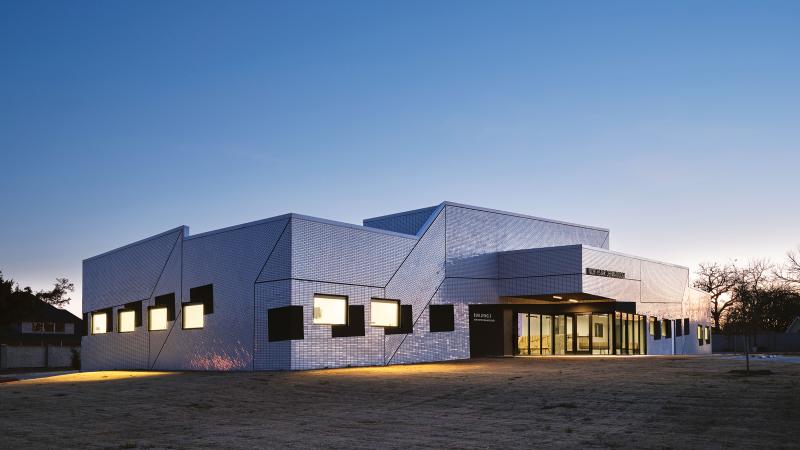AN.ONYMOUS designs Northstar Medical Campus
AN.ONYMOUS, a design office led by Knowlton School Architecture faculty Iman Ansari and Marta Nowak, has designed Northstar Medical Campus, a 24,000-square-foot medical office development located outside of Fort Worth, TX. The three-acre medical campus comprises three single-story medical office buildings that are arranged around a public plaza and surrounded by landscaped grounds. Building 2, housing Northstar Dermatology, a 9,000-square-foot office building was completed in January 2022. The other two buildings, Building 1 and Building 3, are forthcoming and scheduled to be completed by 2024.
The project, through its novel application of simulation tools and representation techniques, not only challenges the conventions of architectural design process and the planning and organization of medical office spaces, but also the use of vernacular building materials and construction techniques. The result is a dynamic environment that offers various forms of visual and physical interactions within the building, as well as with the architecture itself.

Northstar Dermatology’s floor plan is divided into two overlapping rectangular areas that are slightly offset and rotated in relation to one another. Each rectangular area houses a clinical zone, including doctors’ offices, a nurses’ station, and multiple examination rooms. The clinical zones each have an embedded rotation that distorts their original square plan and creates an alignment between the other clinical zone. This subtle rotation also transforms the square volumes of the interior into irregular octagonal ones that in turn facilitate circulation and communication around the nurses’ stations.
The unique plan was developed in order to increase circulation efficiency and interaction between users in the space through the use of agent-based computer simulation software, including Pedestrian Dynamics and AnyLogic, that allowed the specific movement and behavior of doctors, nurses, patients, and staff to be simulated in a digital environment. Rather than using the tools to test or validate an established scheme, AN.ONYMOUS used the software as an experimental design tool itself. By setting the main spaces in a digital model and running the simulated movement of various healthcare users (patients, staff, doctors, nurses) multiple times, the design firm observed the performance and continually modified the floor plan to increase efficiency and reduce unwanted obstructions or interactions.

“In this way, the building, beyond a formal or aesthetic container, functions as a framework to improve the movement and interactions of various users in space,” says Marta Nowak, co-founder and principal of AN.ONYMOUS.
AN.ONYMOUS’s innovative approach towards the interior organization and layout of the clinic also extends to the application of materials and construction techniques used in the project, and in particular the use of a brick veneer or thin brick system. The design office found a way to appease the building requirement by the City of North Richland Hill in which all commercial buildings must have a 80% masonry exterior. Resembling brick in appearance, the glazed black and white brick facades of Northstar Dermatology are not structural but rather operate as a form of orthographic representation, using control joints as lines, the brick-veneer walls as surfaces, and the “shadow” Exterior Insulation and Finish System (EIFS) areas as openings or cut-outs. The finished product reflects light and colors, and given the position of the buildings on a hill, it produces varying effects throughout the course of the day. The thin brick system, used with varied stacked and running bond patterns in horizontal and diagonal arrangements, exposes the symbolic quality of the material as a faux brick.

“The exterior facades function as two-dimensional surfaces that attempt to represent, but never fully correspond to, the logic of the interior,” said Iman Ansari, co-founder and principal of AN.ONYMOUS. “In doing so, the project aims to reveal the disjunction between the interior and the exterior, the structure and the skin.”
The interior finishes and flooring signify and distinguish the public (patients) spaces from the private (staff) areas. The dark gray vinyl flooring of the public areas differentiate them from the light gray private areas, functioning as a form of wayfinding and signage that guide the patients from check-in and waiting room to exam rooms and check-out areas.
The central staff area is framed by a large custom-made white oak reception desk made of four hundred varying heights and individual CNC-cut panels. The same white oak material at reception is carried through to the nurse stations and the examination rooms, serving as a material interface between the patients and the clinic. The varying height of the wood panels in the reception area and nurse stations create openings to provide physical and visual connection on the sides that serve patients and offer privacy on the other sides where staff work.
Northstar Dermatology and its surrounding campus challenge not only the way medical facilities are built but also how they intrinsically work. By applying simulation tools to track users’ movement through the space and exploring alternate representation techniques such as faux brick, the building presents a contemporary interpretation of a traditional building typology.


